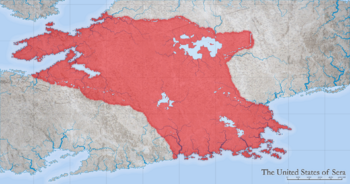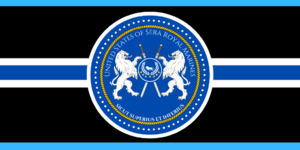Unified Sera: Difference between revisions
Unified Sera (talk | contribs) No edit summary |
Unified Sera (talk | contribs) No edit summary |
||
| Line 9: | Line 9: | ||
|national_motto = ''Not For Self, But Country'' | |national_motto = ''Not For Self, But Country'' | ||
|national_anthem = [https://www.youtube.com/watch?v=kQ6e7SrGR8k ''I Vow to Thee, My Country'']<ref>https://en.wikipedia.org/wiki/I_Vow_to_Thee,_My_Country</ref> | |national_anthem = [https://www.youtube.com/watch?v=kQ6e7SrGR8k ''I Vow to Thee, My Country'']<ref>https://en.wikipedia.org/wiki/I_Vow_to_Thee,_My_Country</ref> | ||
|image_map = | |image_map = SeraMap.png | ||
|alt_map = | |alt_map = | ||
|map_caption = Present Day map of Unified Sera | |map_caption = Present Day map of Unified Sera | ||
|image_map2 = | |image_map2 = | ||
|alt_map2 = | |alt_map2 = | ||
|map_caption2 = A map showing the 24 individual states that make up the federation. | |map_caption2 = A map showing the 24 individual states that make up the federation. | ||
Revision as of 22:01, 13 August 2021
The United States of Sera Syra'yte doh Pro'ven Uso செரா ஐக்கிய நாடுகள் | |
|---|---|
|
Flag | |
| Motto: Not For Self, But Country | |
| Anthem: I Vow to Thee, My Country[1] | |
 Present Day map of Unified Sera | |
| Capital | Kito'Bahari |
| Largest city | Ayotola |
| Official languages | Seran, Latin, Kiswahili, English |
| Demonym(s) | Seran |
| Government | Federal Constitutional Monarchy |
• Monarch | Skolas Keegar Tu'Aruc ya Koga |
| Akan Khalfani ya Mbaku | |
• Speaker of the Senate | Gabadeli Uyise ya Koga |
• Secretary of State | Julius Clamentius ya Latinius |
• Secretary of War | Jabari Mansa ya Mbaku |
• Secretary of the Treasury | Djene Laku ya Sakhile |
• Chief of Staff | Mufari Sifa ya Koga |
| The Senate | |
| Chamber of Representatives | |
| Establishment | |
• Seran Tribes settle a small portion of the Seran coast | circa 1200 B.C. |
• The Quadrumvirate comes into power | circa 1386 A.D. |
• Unification Day | June 7, 1741 |
| Population | |
• 2020 estimate | 50,000,000 |
• Density | 122.3/sq mi (47.2/km2) |
| GDP (nominal) | 2020 estimate |
• Total | 948.5 billion |
• Per capita | 18,600 |
| HDI (2019) | 0.89 very high |
| Currency | Unity (UNI) |
| Date format | mm-dd-yyyy |
Unified Sera, officially known as the The United States of Sera, Syra'yte doh Pro'ven Uso, and செரா ஐக்கிய நாடுகள் is a federal constitutional monarchy located on the Adula continent in the Coalition of Crown Albatross. It shares land borders with Peoratia, Buckingla, Zalluabed, and Togaria, and it also shares maritime borders with Austrolis and Timeria along the southwestern arm of the Albarine Sea and the Sea of Austrolis. Geographically, Unified Sera has a sizeable coastline in the Sea of Austrolis with several beaches, dockyards, and shipping ports that extend Seran commerce into the greater world.
With Ayotola as the most populous city in the country, Kito’Bahari (‘’the Ocean’s Jewel’’) serves as the national capital and is located in the Seran state of Kado near the northwestern portion of the country. The capital is home to the Palace of Kings; the official residence and seat of power of the monarch which lies within the ancient homeland of the Koga tribespeople. The other branches of government are split between the ancestral homelands of the other tribes with the legislative branch located in the Latinius home of Aeminium, the judicial in the Mbaku homeland of Anansi, and the executive in the Sakhile’s origin Shaka. The separation of the 4 parts of Sera’s government was an integral part to Sera’s founding. The Quadrumvirate desired a unified country where they would all be equals and therefore placed each branch of government in the four tribes that made up what would become Sera.
Approximately 3,000 years ago ancient peoples hailing from what would become Timeria sailed to southern Adula and settled the coastlines and interior of south Adula and formed their own tribes, tongues, and cultures as they made their home in Adula. The United States of Sera originated from the Union of Seran Tribes which formed the basis of the modern Seran government. The majority of Unified Sera’s GDP comes from the manufacturing, arms manufacturing, agriculture, and technology industries which play a major part in employing, feeding, and equipping the Seran people. Smaller amounts of revenue is generated from Mercenaries, ship-building, and hemp-based agriculture industries.
Etymology
History
Pre-Discovery (10,000 B.C.E.-1700 A.D.)
Human development and migration
The area that would become Sera was originally settled by migrant peoples sailing from parts of ancient Timeria to the continent of Adula. These peoples would eventually settle the islands, inlands, highlands, valleys, and coastline and establish their own cultures and tribes. The peoples settling the coastline developed a close relationship with the ocean and fishing.
Anthropologists have found extensive evidence of boats capable of sailing in the open water with room for fishing nets and up to four men. There have also been discoveries of boats that could even sail across the Sea of Austrolis to the neighboring continent which sparked theories that stated that the first peoples in the region are closely related to those living in modern day Timeria.
Further inland the land is more fertile and therefore allowed the people who settled in the region to become more agrarian and settle more permanently on the land. Evidence suggests that the ground was used extensively to grow crops such as wheat, barley, corn, beans, onions, and other staple rotational crops. Moreover, bones and rudimentary artwork depicts some grazing from cattle.
In the Savannah and highland areas, the lack of plentiful rainfall and fertile ground forced those living in the area to turn to hunting for food. These people followed the migration of pack animals in the region and lived a highly nomadic lifestyle. Anthropologists believe that they supplemented their diet with wild grains, berries, and fruits found in certain parts of the region. However, their diet mostly consisted of consuming most of the animal parts to utilize the minerals and vitamins within the tissues. As there were no permanent structures due to their lifestyle, what is known of these people are only what was passed down through oral tradition and what was left behind in the form of tools, bones, and weapons.
Early civilizations
The Koga people took up residence in the north-western portion of the continent. The Koga, a deeply religious tribe with strong family units, revered the god Tiyamike and the sky. This is due to their close connection with agriculture and farming, which allowed the Koga to settle the land they lived upon and build some of the first towns and villages in ancient Sera. They traded extensively with the Latinius tribe to their south-west and defended each other from the more warlike clans to their east and hostile invaders from across the sea. This would eventually culminate in a more stable union as the two tribes would create trade networks protected by professional soldiers from a new warrior caste instituted to compete with the warriors from the neighboring tribes. Some of Sera's first cities were built during this time; though many of these cities would be abandoned due to constant war and fighting between the tribes.
The Mbaku and Sakhile tribes aligned themselves due to the harshness of the environment wherein which they lived. A hardy people by nature, the two tribes relied on the grazing migratory animals in the Mbaku controlled mountainous regions and the harsh, dense jungle of the Sakhile to provide enough food to feed their chiefdoms and warriors. They routinely raided neighbors for food, slaves, and other valuable resources that could not be found within either of their domains. This would consistently put them at odds with the Koga and Latinius to their east and would bring about decades of on and off skirmishes between the four groups.
Eventually, the rising threat of other neighboring tribes, kingdoms, foreigners, and colonial powers would bring the four tribes together as a loose confederation headed by the four chieftains of each tribe as a council. This council would balance the ever evolving demands of their people and the growing external threats until the formation of the Union of Seran Tribes in 1386.
As a more unified nation, the four chieftains formed the Quadrumvirate and ruled over each of their lands and aided the others part of the union whether it be in the form of food, defense, or resources. Together, the Quadrumvirate was able to fortify the tribal borders and solidify their hold on their territory in the Seran heartland. Although this union was not perfect due to hundreds of years of prior tribal fighting and cultural differences, the discord would never rise to armed conflicts. For several hundred years the Quadrumvirate and their children ruled and guided the Union of Seran Tribes and defended the land against aggressors both foreign and domestic.
Formation of the United States
After roughly 400 years of Quadrumvirate rulership, the shifting global landscape necessitated a more unified nation going forward. The Quadrumvirate was not keen on losing power, however they came to the decision that
18th-19th Centuries
Early Expansion
Early 20th Century
Geography and Climate
States
The state system is a direct result of Sera's tribal roots. Originally, the four tribes that resided in what would become Sera lived under a tribal confederation within their respective tribes. Each village made up the larger confederation under a chieftain who led the entire tribe. When the Quadrumvirate formed the Union of Seran Tribes, the villages that formed the states in each confederation became a state in and of themselves, which led to the first twelve states in Sera. Although technically, the Union of Seran Tribes is a different government than the United States of Sera of today, the United States of Sera still observes the date that the states originally joined what would become the federation some 250 years later.
There are currently 24 states in the federation.
| State | Capital | Population | Admission into Federation |
|---|---|---|---|
| Aeminium | Invicta | 4,112,000 | June 7th, 1386 |
| Carpathia | Novarii | 3,543,000 | June 7th, 1386 |
| Augusta | Jullii | 1,246,000 | June 7th, 1386 |
| Reginum | Roma | 2,132,000 | June 7tth, 1386 |
| Istrus | Hadrian | 1,002,000 | March 15th, 1399 |
| Rhodes | Scipii | 875,000 | December 12th, 1491 |
| Kado | Kito'Bahari | 7,213,000 | June 7th, 1386 |
| Etoule | Andile | 711,000 | June 7th, 1386 |
| Mwindo | Zola | 684,000 | January 8th, 1946 |
| Shaka | Mombasa | 3,212,000 | June 7th, 1386 |
| Enyebi | Djenne | 1,823,000 | June 7th, 1386 |
| Sifya | Kaang | 1,473,000 | June 7th, 1386 |
| Njogu | San | 725,000 | May 1st, 1543 |
| Mali | Sankore | 4,824,000 | June 7th, 1386 |
| Xanthus | Arverni | 183,000 | July 19th, 2021 |
| Zulu | Armansi | 4,523,000 | June 7th, 1386 |
| Mansa | Jengo | 821,000 | September 12th, 1403 |
| Anansi | Axsum | 1,247,000 | August 1st, 1553 |
| Carthage | Ayotola | 8,523,000 | June 7th, 1386 |
| Jakesh | Ngai | 524,000 | January 22nd, 1723 |
| Yobu | Takhar | 348,000 | February 8th, 1881 |
| Nakane | Sheba | 256,000 | November 20th, 1901 |
| Musa | Zambezi | 211,000 | January 1st, 1922 |
| Kefa | Nyaminyami | 430,000 | January 1st, 1922 |
Cities
|
10 Largest Metropolitan areas in Unified Sera by population | |||||
| No. | CMA City |
Population | |||
| 1 | Ayotola | 5,843,000 | |||
| 2 | Kito'Bahari | 4,626,000 | |||
| 3 | Sankore | 2,786,000 | |||
| 4 | Memphis | 1,523,000 | |||
| 5 | T'Chaka | 1,289,000 | |||
| 6 | Myalla | 1,181,000 | |||
| 7 | Abyssia | 967,000 | |||
| 8 | Mombasa | 823,000 | |||
| 9 | Djenne | 489,000 | |||
| 10 | Axsum | 433,000 | |||
Education
Ethnicity
Family Structure
The traditional family structure in the United States of Sera is considered a family support system involving two married individuals who have reached the age of majority either federally, or at the state level, and are providing care and stability for their biological or adopted offspring. Serans have a particularly strong relationship with family and the members within, as most Serans are religious and place heavy emphasis on the rearing and development of children, parents typically seek the best for their children. On average, societal and generational pressures cause these family units to put the needs of their children ahead of their own where possible in an attempt to get the most desirable traits to manifest within their offspring.
Language
Seran is the de facto national language of the United States of Sera. Although there are four official languages at the federal level, The U.S. Immigration and Naturalization Act requires immigrants to learn and be at least conversational in Seran or English. At the state level, many states have declared one of the four federally recognized languages to be their official language. Only one state in Sera's eastern portion recognizes a non-federally recognized language to be the official language of the state. In the state of Kefa the native language of Ze'tecan is spoken by the majority of the population living in the state.
According to the Seran Community Survey, in 2017 some 43 million people (out of the total U.S. population of 50.5 million) spoke two languages at home. Among these, Seran was the most spoken with Latin. More than 23 million spoke English at home, making it the second most commonly used language in the United States of Sera. Other languages spoken at home by one million people or more include Kiswahili (2.8 million), Ze'tecan (1 million), and Yoruba (1.4 million).
The most widely taught foreign languages in the United States of Sera in terms of enrollment numbers from kindergarten through university undergraduate education, are English (around 7.2 million students), and Timerian (1.5 million).
Religion
Predominant faiths
Cults
Government
Royal Cabinet
Placeholder
| Office | Incumbent | Took Office |
|---|---|---|
| Secretary of State | Julius Clamentius ya Latinius | November 29th, 2019 |
| Secretary of the Treasury | Djene Laku ya Sakhile | November 29th, 2019 |
| Secretary of War | Jabari Mansa ya Mbaku | November 29th, 2019 |
| Secretary of the Interior | Gaius Decimus ya Latinius | November 29th, 2019 |
| Secretary of Agriculture | Amari Sensa ya Koga | November 29th, 2019 |
| Secretary of Labor | Palus Legatus ya Latinius | November 29th, 2019 |
| Secretary of Commerce | Musa Denga ya Sakhile | November 29th, 2019 |
| Secretary of Health and Human Services | Uyise Ubuntu ya Koga | November 29th, 2019 |
| Secretary of Transportation | Djene Jenne ya Koga | November 29th, 2019 |
| Secretary of Energy | Lucius Commodus ya Latinius | November 29th, 2019 |
| Secretary of Education | Maxima Opis ya Latinius | November 29th, 2019 |
| Director of Aegis | Badu Ayeh ya Mbaku | November 29th, 2019 |
| Director of the Seran Space Agency | Kobi Sarbei ya Mbaku | November 29th, 2019 |
Eligibility for Political Office
Monarch
Military
United States of Sera Army
The United States of Sera Army, also called the Unified Sera Army, US Army, and Seran Army is a branch of the Seran military beneath the High Command of the Armed Forces and Joint Chiefs of Staff Committee. The US Army is headed by the Chief of the Army, a member of the Joint Chiefs of Staff, and the highest ranking army officer. The US Army was officially established on June 7th, 1736 by the Quadrumvirate in the present day capital of Kito'Bahari in response to growing external threats to the Union of Seran Tribes. Before the establishment of a national army, each state in the Seran Union provided their own troops and commanders for national defense. These commanders were prone to disagreements with each other, while soldiers from different tribes would routinely fight amongst themselves due to cultural differences. The Quadrumvirate sought to nullify the worst offenders by removing them from their position and sending them to prison to avoid possible coups against the Quadrumvirate. Soon thereafter, new commanders were appointed from within the tribes to take their place with a particular focus on unification and standardization over individualization and cultural differences.
Originally, the US Army handled both peacekeeping tasks domestically within the first tribal states while also juggling the demands of protecting the borders around the fledgling country from the neighboring violent tribes of ancient Adula. The Quadrumvirate, fearing nepotism, instituted a system amongst Sera's warriors that rewarded soldiers with prestige, wealth, and position for accomplishing certain tasks. These tasks included bringing the heads of enemy war-leaders, scalps, securing weaponry, repelling attacks, and spear-heading successful raids against enemy territories. Due to the ferocity at which Seran warriors pursued enemy heads and scalps, a reputation began to grow amongst their neighbors surrounding Seran brutality in war.
This reputation continued to grow as the Union of Sera entered into a war with the neighboring Nafuni Ze'teca Tribe known as the Seran-Ze'teca Extermination War. The conflict broke out when the Nafuni Ze'teca tribe crossed the Adula Mountains and entered into the Mbaku controlled tribe-lands. The Ze'teca immediately began to pillage and destroy any villages they came across and murdered any Seran inhabitants they captured. The newly formed national army was dispatched to combat the Ze'tecas. The Seran Army clashed several times over the next four years with the Ze'tecas; each time the officers in charge of the Seran soldiers ordered that no mercy be shown. Eventually, this harsh treatment of the Ze'teca would lead to the near total annihilation of the Nafuni Ze'teca nation as the Seran Army chased them across the mountains into their homeland. Although victorious, the Quadrumvirate quickly did away with the practice of rewarding soldiers for heads and scalps, partially due to the shame of nearly committing genocide.









